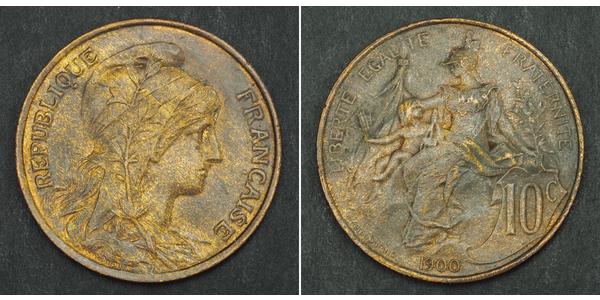(售价 $2.0)
1900, France (3rd Republic). Beautiful Bronze 10 Centimes "Marianne" Coin. XF!
Condition: XF! Mint Year: 1900 Mint Place: Paris Reference KM-843. Denomination: 10 Centimes Diameter: 30mm Material: Bronze Weight: 9.94gm
Obverse: Female bust, wearing phrygian cap (also known Marianne) and oak wreath right. Engraver´s signature below. Legend: REPUBLIQUE FRANCAISE
Reverse: Togate allegoric figure (personification of France) holding olive branch beneath a child, which has wheat-sprays in right hand. Value (10c) to right, date (1899) below. Legend: LIBERTE EGALITE FRATERNITE / 10 C / 1900
Marianne is a national symbol of the French Republic, a personification of liberty and reason, and a portrayal of the Goddess of Liberty. Marianne is displayed in many places in France and holds a place of honour in town halls and law courts. She symbolizes the Triumph of the Republic, a bronze sculpture overlooking the Place de la Nation in Paris, and is represented with another Parisian statue in the Place de la République. Her profile stands out on the official government logo of the country, is engraved on French euro coins and appears on French postage stamps; it also was featured on the former franc currency. Marianne is one of the most prominent symbols of the French Republic, and is officially used on most government documents. Marianne is a significant republican symbol, opposed to monarchy, and an icon of freedom and democracy against all forms of dictatorship. Other national symbols of France include the tricolor flag, the national motto Liberté, Égalité, Fraternité, the national anthem "La Marseillaise", as well as the coat of arms and the official Great Seal of France.
The French Third Republic (French: La Troisième République, sometimes written as La IIIe République) was the republican government of France from 1870, when the Second French Empire collapsed, to 1940, when it was replaced by the Vichy France government after the French Third Republic's defeat to Nazi Germany in the early stages of World War II.
The early days of the Third Republic were dominated by the Franco-Prussian War, which the Republic continued to wage after the fall of the Emperor. Harsh reparations exacted by the Prussians after the war resulted in the loss of Alsace-Lorraine, social upheaval, and the establishment of the Paris Commune. Early governments of the Third Republic considered re-establishing the monarchy; however, confusion as to the nature of that monarchy, and who among the various deposed royal families would be awarded the throne, caused those talks to stall. Thus, the Third Republic, which was originally intended to be a transitional government, instead became the permanent government of France.
The French Constitutional Laws of 1875 gave the Third Republic its shape and form, consisting of a Chamber of Deputies and a Senate forming the legislature, and a President serving as the head of state. Issues over the re-establishment of the monarchy dominated the Presidency of the first two Presidents, Adolphe Thiers and Patrice de Mac-Mahon, though a series of republican presidents during the 1880s ended any hope of a monarchy. The Third Republic established many French colonial possessions as France acquired French Indochina, Madagascar, French Polynesia, and large territories in West Africa during the Scramble for Africa, all acquired during the last two decades of the 19th century. The early years of the 20th century were dominated by the Democratic Republican Alliance, which was originally conceived as a centre-left political alliance, but which came to become the main centre-right party over time. The period from the start of World War I to the late 1930s featured sharply polarized politics, between the Democratic Republican Alliance and the more Radical socialists. The government fell during the early years of World War II, as the Germans occupied France and was replaced by the Vichy government of Philippe Pétain.
Maurice Larkin (2002) argued that political France of the Third Republic was sharply polarized. On the left marched democratic France, heir to the French Revolution and fully assured of the power of reason and knowledge to create a better future for all Frenchmen and all mankind. On the right stood conservative France, rooted in the peasantry, the Church and the army, and skeptical about "progress" unless guided by traditional elites. Adolphe Thiers called republicanism in the 1870s "the form of government that divides France least". The Third Republic endured seventy years, making it the longest lasting government in France since the collapse of the Ancien Régime in 1789.
416 coins were grouped from 2015-08-10 to 2015-08-25
其中一个是:
1 Crown 大不列颠及爱尔兰联合王国 (1801 - 1922) 銀 维多利 ...
本组有 126 钱币 / 119 售价
⇑
其中一个是







-300-150-GrQK.GJAlKEAAAEuYZG1Likn.jpg)
-300-150-C0MKbzbi_B0AAAFPNZSr70SQ.jpg)







